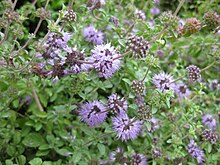Mentha pulegium
| Mentha pulegium | |
|---|---|
 |
|
| Scientific classification | |
| Kingdom: | Plantae |
| (unranked): | Angiosperms |
| (unranked): | Eudicots |
| (unranked): | Asterids |
| Order: | Lamiales |
| Family: | Lamiaceae |
| Genus: | Mentha |
| Species: | M. pulegium |
| Binomial name | |
|
Mentha pulegium L. |
|
Mentha pulegium, commonly (European) pennyroyal, or pennyrile, also called squaw mint, mosquito plant and pudding grass, is a species of flowering plant in the family Lamiaceae native to Europe, North Africa, and the Middle East. Crushed pennyroyal leaves exhibit a very strong fragrance similar to spearmint. Pennyroyal is a traditional culinary herb, folk remedy, and abortifacient. The essential oil of pennyroyal is used in aromatherapy, and is also high in pulegone, a highly toxic volatile organic compound affecting liver and uterine function.
Pennyroyal was commonly used as a cooking herb by the Greeks and Romans. The ancient Greeks often flavored their wine with pennyroyal. A large number of the recipes in the Roman cookbook of Apicius call for the use of pennyroyal, often along with such herbs as lovage, oregano and coriander. Although it was commonly used for cooking in the Middle Ages, it gradually fell out of use as a culinary herb and is seldom used as such today. The fresh or dried leaves of the plant were used to flavor pudding.
Even though pennyroyal oil is extremely poisonous, people have relied on the fresh and dried herb for centuries. Early settlers in colonial Virginia used dried pennyroyal to eradicate pests. Pennyroyal was such a popular herb that the Royal Society published an article on its use against rattlesnakes in the first volume of its Philosophical Transactions in 1665.
...
Wikipedia
